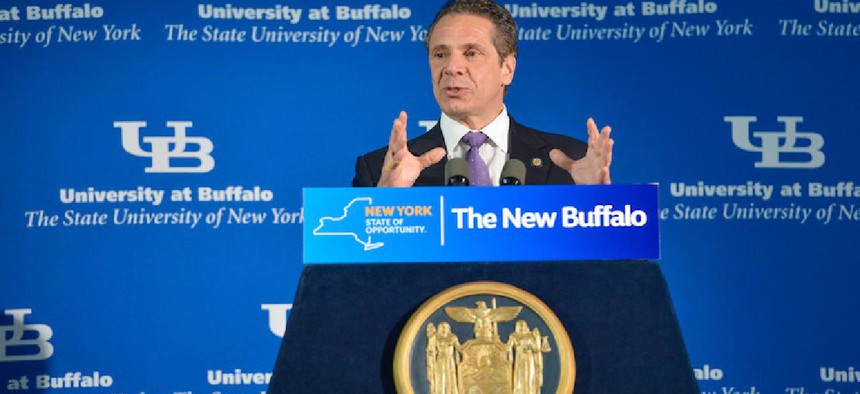It'll be disguised for a while, but soon enough, the further dwindling of the financial services sector in Buffalo will become as noticeable as the ongoing shrinkage of the manufacturing sector in New York's second-largest metro area. The broadly positive job numbers in the Buffalo-Niagara Falls metro area during the Obama recovery echo the national trend: low-wage jobs abound, but high-wage employment, in those aforementioned sectors in particular, is far less robust.
That's why Gov. Andrew Cuomo and Sen. Chuck Schumer spent the spring of 2016 warning Washington regulators against rubber-stamping Buffalo-based First Niagara's acquisition by Cleveland-based KeyBank. But the finale was preordained: there was never going to be a regulatory obstacle to one small regional bank acquiring another, given that neither had the money-laundering and other regulatory inquiries facing M&T Bank in its arduous slog to acquire a New Jersey regional bank.
But any consolidation, merger or acquisition means that jobs will be lost. During the Great Recession of 2008-2011, there was a net loss of financial-services sector jobs in Buffalo. Then HSBC left Buffalo after selling its branch offices to First Niagara, a friendly process that meant a handover of the branch bank on the corner to locals. But by the end of HSBC's departure, 600 highly-paid IT personnel and about 1,500 people in the mortgage business, commercial bankers and dozens of senior executives were gone, along with the big bank's philanthropy and the principal tenant of Buffalo's tallest office building, which before the fire sale was assessed at over $80 million and now has questionable worth, if any.
And location matters. KeyBank's roots are in Albany, but it moved in the 1990s to Cleveland. Now it's moving its headquarters to Buffalo – but that could mean downsizing in the state capital, where the Albany Times Union reports that in 2015, KeyBank reduced its rental footprint from 120,000 square feet to 41,000 square feet. The latest available data from the Bureau of Labor Statistics show that from 2012 to 2015, there were about 12,000 people employed in the very broadly defined “finance and insurance” sector in Albany County, and about 25,000 in Erie County. Shifting activities to Buffalo may not mean a loss for Albany, but then Albany has already lost a couple of hundred commercial bankers since 2012.
Shareholders and executives like mergers and acquisitions. So do the lawyers and other transaction consultants who engineer them. KeyBank's asset base grows by $39 billion from its previous $98.4 billion, which makes the new bank in town bigger than Bob Wilmers' M&T Bank, whose assets totaled $123 billion at the end of 2015.
But what does having two large regional banks (where before there was one large regional bank and one branch of planet Earth's third-largest bank) mean to upstate New York's economy?
Chances are, branch banks that had HSBC stationery and signage six years ago will have KeyBank stationery and signage by the end of 2016. It would surely be news if there will be net new employment in a consolidating sector – retail bankers are in the business of servicing existing customers; they are not investment bankers arranging the creation of new enterprises that need more retail bankers.
And then there’s the footprint, which probably won’t change. Downtown Buffalo's office vacancy rate of 23 percent does not include the nearly 1 million square feet of the former HSBC tower. KeyBank won't need any new office space. It acquired an existing tenant of the much-celebrated Larkinville district, which owes its existence not only to the entrepreneurship of its owners, but also to the demolition of a repurposed historic downtown theater to make way for a new federal court building – which is across Niagara Square from the old one.
In Buffalo, new signage and surplus inventory are still thought of as signs of economic recovery. But as our own research from 2010, and the Rockefeller Institute’s 2014 report on regional cash flows also shows, the resilient, diverse economies of the Buffalo, Rochester, Syracuse and Albany metropolitan areas still require enormous annual state subsidies – above and beyond the Buffalo Billion and the other brand-new injections of Albany’s cash into new tech-focused economic development projects.
Retail banking is a part of that economic diversity. An upstate New York homecoming for KeyBank should not, however, be expected to result in economic growth.
Bruce Fisher is director of the Center for Economic and Policy Studies, and visiting professor in the Economics and Finance department, at Buffalo State College.


